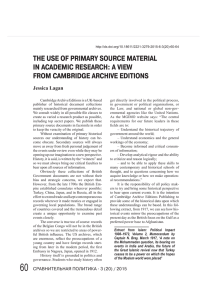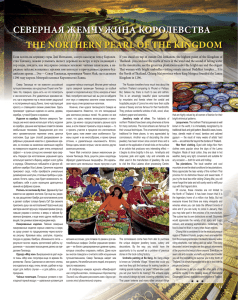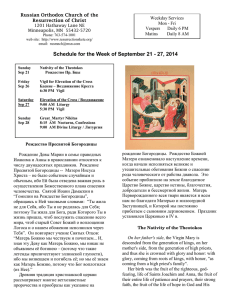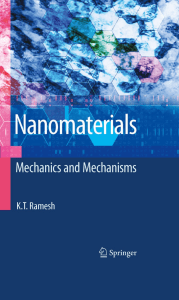Folie 1 - кремний-2010
реклама
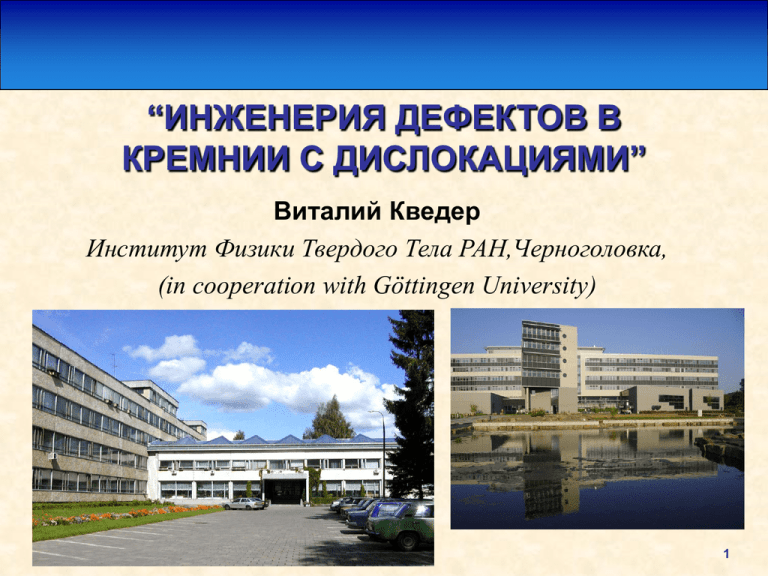
“ИНЖЕНЕРИЯ ДЕФЕКТОВ В КРЕМНИИ С ДИСЛОКАЦИЯМИ” Виталий Кведер Институт Физики Твердого Тела РАН,Черноголовка, (in cooperation with Göttingen University) 1 Кремний является не только основным материалом микроэлектроники, но и основным материалом солнечной энергетики, которая по вкладу в ВВП может скоро превысить микроэлектронику… За 10 лет производство солнечных батарей выросло более чем в 20 раз и продолжает расти экспоненциально! Сейчас солнечные батареи делаются в основном (на 95%) из Si Кремния очень много в природе, он нетоксичен и, в принципе, позволяет производить солнечные батареи с кпд до 24% и с большим (до 50 лет) сроком службы… Тандемы Si- a-Si:H позволяют, в принципе, повысить кпд до 30% Общая мощность установленных солнечных батарей уже превысила 15 ГВт. 2 Расходы на исследования в области фото-вольтаики в Германии (в Млн. Евро) 3 Основная задача – снизить цену киловатт-часа производимого солнечными батареями… Требуется увеличить отношение: (КПД*Срок_Службы)/ Себестоимость 4 И тогда, через 40-50 лет солнечные батареи станут основным источником энергии для людей… 5 Как снизить стоимость солнечных элементов из Si ? Использование более дешевого кремния- сырья (вместо EG-Si => более грязный SG-Si из силана или хлорсилана или еще более грязный UMG-Si улучшенный металлургический кремний….) Более дешевые методы изготовления ваферов (вместо C-Si => poly-Si, причем желательно выращивать сразу в виде тонких лент или слоев) Casting, EFG, silicon sheets from powder (Fraunhofer), silicon on substrate, nano-Si films …. 6 Основная проблема – маленькое время жизни фотовозбужденных электронов в дешевых поли-Si ваферах… Схема солнечного элемента. Чтобы эффективно использовать всю толщину вафера надо иметь: LDe=(De*te)1/2 >2d (LDe -диффузионная длина электронов) Для d=100 микрон, te > 12 ms Для d=200 микрон, te > 48 ms… 7 Чем определяется время жизни неосновных носителей в дешевом поли-кремнии? te определяется электрон-дырочной рекомбинацией на глубоких уровнях, обусловленных, прежде всего: -Растворенными в объеме электрически активными атомами переходных металлов (Fe, Cr, Au, Ti, Ni….) и их комплексами с другими примесями и дефектами… -Электрически-активными примесными преципитатами -Дислокациями в зернах и в границах зерен. LBIC - Распределение фототока солнечного элемента (T=300K) вдоль его поверхности (чем выше ток тем светлее изображение). Там где много дислокаций, ток маленький потому что электроны рекомбинируют на дислокациях и не доходят до коллектора. 8 Что мы уже знаем о дислокациях в Si ? К счастью, в Si большинство дислокаций генерируемых пластической деформацией при T> 600oC – расщепленные скользящего набора (dissociated 0o and 60o of the glide set). 9 Shockley partial dislocations are reconstructed and produce only relatively shallow 1D bands EDe and EDh, split from conduction and valence bands by the dislocation strain. Core view in the glide (111) plane of 30o (left) and 90o (right) Shockley partial dislocations in their unreconstructed (A) and reconstructed (B) states. Reconstruction energy gain is of about 0.5 eV/bond However, they can have deep localised electronic states due to: 1. core defects (reconstruction solitons, jogs…) 2. Impurity atoms 10 e-h recombination at dislocation… Capture of free electrons and holes to 1D-bands. Their motion along dislocation Capture from the 1D bands to deep states of defects and recombination. Transitions between 1D-bands (1) give small recombination rate, i,e, recombination at ’clean’ dislocation is small. But, recombination is drastically enhanced by presence of even a small concentration of deep levels defects at dislocation. 11 Theoretical calculations… [V.Kveder, M.Kittler, W.Schroter, Phys.Rev.B 63, 115208 (2001)] Coulomb band-bending, repulsive for majority carriers but attractive for minority carriers + Strong “amplification” of deep-level recombination by 1D bands (at low NDD) At very large NDD total recombination rate can be smaller than for the same number of metal atoms randomly distributed in a bulk (charge and diffusion limitation) 12 e-h recombination at dislocation – experiments (EBIC, LBIC) It was found by many authors that recombination rate at dislocation vary strongly from sample to sample and depends strongly on contamination level. Perfect agreement with theory. At high excitation recombination rate decreases strongly due to decrease of dislocation charge 13 Why dislocations collect impurities ? Segregation in the strain field around dislocations (EB~0.4-0.8eV, R~1-2 nm) Binding to the dislocation core (EB up to 2-3eV !, R<0.5nm) Preferential nucleation of metal silicide particles at dislocation when metal impurities gets supersaturated during cooling. (Because barier is lower and concentration is higher). Preferential growth of metal particles near dislocation which works as a sink for V and Si-I. Combinations of all these 4 factors are possible! The electronic properties of impurities at dislocation may differ from those in bulk! Obviously, we need more research to clarify the situation for different impurities ! 14 Interaction with strain field. The dominant term of elastic interaction comes from the difference in size of Si atom (r0r0 = 0.117 nm ) and impurity atom (rimp): DE(x,y)~ P(r0-rimp)3 In average it is of the order of ~0.30.7eV (depending on impurity type). At T>500oC it cannot give large number of atoms at dislocation. But, it is long distance interaction and can enhance strongly kinetic of incorporation of impurities to the chemically-bonded state in dislocation core and, also, can enhance precipitation kinetic. 15 Chemical interaction with core… According to calculations, some impurities have large binding energies in dislocation cores. Usually, some energy barrier should be overcome, which is different for different places (RD, jogs…) The electronic properties of impurities at dislocation core can strongly differ from those in a sample bulk. Usually, several configurations of atom in a core with different properties are possible Example: Au at dislocations [N.Fujita, A.T.Blumenau, R.Jones, Soberg, P.R.Briddon] Strong increase of Au solubility in dislocated Si was experimentally confirmed by NAA [A.Rodriguez, H.Bracht, I.Yonenaga, J. Appl. Phys., 95, 7842, (2004)] 16 Что делать? – Использовать «инженерию дефектов» в процессе изготовления солнечных элементов ! 1. «Геттерирование» - собирание опасных атомов переходных металлов в местах где они не опасны… - «segregation gettering» - за счет большей растворимости примеси в геттере. Не требует пересыщения объема вафера примесью. (Например PDG при формировании p-n-перехода и AlG при формировании обратного p-p+ контакта) - «precipitation gettering» - происходит при пересыщения объема вафера примесью за счет преимущественного роста преципитатов этой примеси в области геттера (например, BDG при концентрации бора больше его растворимости). 2. «Пассивация» - превращение электрически активных примесей в электрически неактивные комплексы за счет их реакции с другими примесями и дефектами (например, с водородом) 3. Собирание атомов примеси в преципитаты такой фазы, которая малоактивна в рекомбинации. Например, b-FeSi2 (Т<930oC) – полупроводник – малоактивен, а a-Fe2Si5 (Т>930oC)- металл – очень активен в рекомбинации («внутренний Шотки-контакт») 17 Оптимизации процессов гетерирования требует серьезных исследований ! Примитивный подход: 1. Нагреть до очень высокой T чтобы «испарить» примеси с дислокаций и растворить преципитаты. 2. Охладить очень медленно чтобы примеси успели продиффундировать в место с минимальной энергией (геттер) Но это слишком дорого для практики! Чтобы удешевить процесс требуется найти оптимальный режим. => Следует использовать компьютерное моделирование. Для этого надо знать все основные параметры….. So, systematic investigation of interaction of different impurities with dislocations and their electronic properties is nessesary… Still in progress… 18 Для Si без дислокаций PDG и AlG уже довольно хорошо поняты и созданы соответствующие компьютерные симуляторы. (см. например [V.Kveder, W.Schroeter, A.Sattler, M.Seibt, Materials Science&Engineering B71, 175-181 (2000)]) Геттерирование происходит, в основном, за счет образования комплексов атом металла-фосфор… Пересыщение образца Si-I приводит к ускоренной диффузии substitutional атомов примеси, в ряде случаев, к ускорению «испарения» преципитатов и к увеличению эффективного segregation factor S… 19 Что меняется в случае наличия дислокаций? 1. Дислокации являются «стоками» для вакансий и собственных межузельных атомов. Это ухудшает кинетику PDG, влияет на эффективный коэффициент диффузии примесей, и т.д. Уже включено в некоторые современные компьютерные версии “gettering simulator” 2. Взаимодействие примесных атомов с дислокациями. Это ухудшает и кинетику и эффективность обычных методов гетерирования. Для включения в “gettering simulator” надо знать энергию связи. Пока есть оценки только для Au и Cu… Исследования активно ведутся в нескольких командах. 3. Критическое пересыщение (“nucleation barier”) для образование преципитатов на дислокации гораздо меньше, чем в «хорошем» кристалле. Это затрудняет использование обычных методов «precipitation gettering» и влияет на оптимальные параметры «segregation gettering». Чтобы включить в “gettering simulator требуется экспериментальное определение “nucleation barier” … Состояние исследований неясно… 4. Для вычисления скорости рекомбинации требуется знание электронных параметров для атомов и преципитатов примесей на дислокациях… Исследования активно ведутся в нескольких командах. 20 Прежде чем затевать полномасштабные исследования, хорошо бы убедиться что геттерированием можно в принципе очистить дислокации! DLTS-measurements show that combination of gettering and hydrogen plasma passivation reduces strongly concentration of all deep levels at dislocations (from 3.106cm-1 to below 7.104cm-1) [V. Kveder, M. Badylevich, E. Steinman, A. Izotov, M. Seibt and W. Schroeter, Aplied Phys. Letters, 84(12), 2106-2108 (2004)] 21 Do clean dislocations affect the solar cell efficiency ? EBIC before and after PDG (Kittler et al) Spectra of photo-current for p-n-structure with very high dislocation density after AlG+PDG+H-plasma. Note that Clean dislocations can be also used to make a Si-LED for 1.5m ! [Kveder et al, phys. stat. sol. (a) 202, 901 (2005) ]. 22 Example (1): Ni at dislocation… Evolution of dislocation DLTS spectra of the same dislocations depending on their pre-history (n-FZ-Si, NDIS=105cm-2) The C-line seems to be some impurity at dislocation… (maybe NiS?) [V. Kveder, V. Orlov, M. Khorosheva, M.Seibt, Solid State Phenomena 131-133, 175-181 (2008)] 23 No theory for Ni at dislocation yet… Experiment (TEM) - in presence of dislocations all Ni precipitates seems to be at dislocations… Is Ni at dislocation a “members” of the DLTS C-defect family ? 24 Example 2: Au at dislocations… Theory (N. Fujita, A. T. Blumenau, R. Jones, S. Ӧberg, P. R. Briddon) Atomic structure and binding energies 30o glide, Eb=1.71eV 90o glide, Eb=2.13 eV 25 Au at dislocations… Experiments. 1. There is a lot of Au at dislocation. Dislocations become pined by Au atoms and we can not unlock and move them anymore by stress ! Strong increase of Au solubility in dislocated Si was also experimentally confirmed by NAA [A.Rodriguez, H.Bracht, I.Yonenaga, J. Appl. Phys., 95, 7842, (2004)] 2. But we do not see the DLTS of Au at dislocations (for some reasons). We continue working to understand the situation… 26 Summary and Conclusion “Clean” dislocations in Si are mainly reconstructed and not very active in recombination. Strong interaction of dislocations with transition metal impurities is a key to understand the role of dislocations in poly-Si. The important role of dislocations as heterogeneous nucleation sites for silicide precipitates is beyond doubt. This is important for gettering of metal impurities from dislocated silicon such as typical multicrystalline materials for photovoltaics. Minority carrier recombination at dislocations is consistently described by the concerted action of shallow 1D bands, which are an intrinsic property of dislocations, and deep levels at or close to the dislocation core which seemingly are related to a large extent to impurities. There are still many open questions ! A lot of work for scientists… 27 Thank you for your attention! 28 Spin-dependent reactions of impurities at dislocations: Oxygen Theoretical calculations (R.Jones team) usually gives several possible configurations of impurity at dislocation core… Magnetic field (with or without MW field (EPR)) can change the spin configuration (singlettriplet) in thermally excited state and thus stimulate the change in defect configuration or its dissociation. (spin-dependent chemical reactions). 29 The concentration and state of impurity (for example Oxygen in CZ-Si) at dislocation can be monitored by measurements of Unlocking stress, nessesary to make dislocation mobile again. … Exposition of dislocations decorated by oxygen in static magnetic field at room T results in a strong reduction of pinning effect of oxygen accumulated at dislocation due to change in its configuration stimulated by spin dependent reactions… (see also [I.Yonenaga, K.Takahashi, Journal of Physics: Conference Series 51, 407 (2006)]) [ M.V.Badylevich, Yu.L.Iunin., V.V.Kveder, V.I.Orlov, Yu.A.Osipyan, JETP, 97, 601-605 (2003)] 30 ‘Heating’ of spin-system in EPR conditions make opposite effect compared with static magnetic field. 30 minutes at Т=295К, Р(9.5ГГц)=200 мВт. Before EPR treatment dislocations were contaminated by oxygen atoms at Т=600оС ‘Unlocking stress’ measured at 600oC decreases after 30min exposition in magnetic field B (proportionally to B), but increases after keeping sample in EPR conditions… Two different spin-dependent reactions occur in the same time… 31 the D1, D2 luminescence… • D1 dominates at high T - it corresponds to deeper (and more populated) states •D1 is NOT a phonon replica of D2 (shown also by M.Kittler) • Transitions between 2 levels: one is coupled to conduction, another – to valence band • Radiation recombination at D1&D2 is much faster than Ev-Ec – no emission at 1.1ev ! 32 Dependence on excitation level At low T – tendency to saturation Saturation for deeper states occurs at lower excitation level Can we make a laser with that !? 33 From optical absorption we can estimate the concentration ND of D1-D2 centres… Using Einstein relation between the rates of spontaneous (1/ tR) and stimulated transition one can easily deduce for ND: ND=(8pn2 e tR/c2) ∫a(n) dn We have already estimated tR as (2-3)10-7sec. It gives us : ND=(3-5)1014cm-3 for Ndis=(3-5)108cm-2 So, distance between D1&D2 centres along dislocation is of about 10nm. Fits to idea of jogs, constrictions etc. at dislocation… 34 The nature of D1, D2 is still unknown ! Dislocation jogs, segments of Lomer dislocations, multivacancy and/or self-interstitial clusters trapped in the core ?? Puzzle: why we do not see the D1-centers in DLTS ? Spectra of dislocation luminescence in silicon samples with different dislocation densities ND. The spectra are normalized to show the same integral intensity. 35

